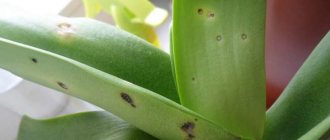Symptoms and causes
If the owner of the cactus does not notice active growth, then this is the first sign that the plant is affected by disease or insects. Also, the reasons could be errors in maintenance, for example, a cactus may not grow if it is not provided with sufficient light, is transplanted incorrectly, or is watered with very cold water.
Another reason for growth arrest may be vaccination, after which the cactus experiences stress. If growth slows after flowering, then perhaps the crop simply became exhausted while the flowers were developing.
In order for the cactus to grow well, it is important to slightly increase the air humidity during the period of active growth, in spring and summer. This can be achieved with household air humidifiers or simply placing a container of water near the pot.
If a dried, wrinkled stem is observed, the gardener is advised to touch it. A dense, hard stem indicates a lack of moisture, and a soft, watery stem indicates its excess. Only replanting with the elimination of all rotten roots will help correct the situation. Sometimes gardeners notice that the color of the cactus's stem and leaves has changed. Yellowness and brown spots indicate the presence of the disease. This may also be due to changes in light conditions, water entering the plant, moving to a new place, or exposure to direct sunlight.
When leaves or flowers drop, it can be assumed that the cause is changes in light, watering or temperature. Untimely replanting or poor soil composition could also be a factor. Insects and diseases are also possible. If the gardener notices that the shoots are drying, then it may be worth increasing the temperature of the water when watering, and also eliminating drafts. Another reason may be injury to the root system during replanting.
Some gardeners notice that the cactus is bent over. Most likely, the plant is simply reaching out to the light source. It is recommended to turn it with the bent side back, but if after 3-4 days the bent flower does not return to its original shape, then most likely it has rotted, and then the reasons must be looked deeper. Rusty spots on the stem may indicate that the air in the room is too cool. Yellowing of the soil indicates a deficiency of useful elements in the soil; it is recommended to feed the cactus with mineral mixtures. Wounds and cracks can be caused by mechanical damage. Sometimes the skin cracks if the crop is overfed with organic matter.
When the roots begin to rot, waterlogging of the soil should be avoided. This process is especially often detected when there is a lack of light and low air temperature. If the resulting wounds or cuts are not disinfected with sulfur, this can also cause rot or mold. Short-term flowering can be caused by a lack of ultraviolet lighting, lack of wintering, errors in the watering procedure, poor-quality soil composition, or “moving” to a new location.
Optimal conditions for growing desert and forest cacti
Cacti came to us from Central and South America and have long taken a strong place in the hearts and also on the windowsills of many gardeners - both beginners and professionals. These plants are very diverse, but in general they are divided into two types: forest and desert. Cacti differ significantly from each other in appearance, which means that the conditions for their maintenance are different.
Among desert cacti, the following are considered the most popular for growing indoors:
- Echinopsis;
- Knippel's Echinocereus;
- Echinocerius crested;
- Echinocactus Grusona;
- Cereus peruviana;
- Chamecereus Sylvester;
- aporocactus whip;
- woolly espol;
- notocactus;
- astrophytum capricornus;
- prickly pear;
- parodies (golden-spined and blood-flowered);
- the rejuvenation is dwarf.
Forest cacti naturally grow under trees or on their crowns. The most common of them among flower growers are:
- rhipsalidopsis;
- epiphyllum;
- zygocactus (Decembrist, Christmas).
One of the most common forest cacti is epiphyllum.
Cacti, whose homeland is deserts, love plenty of sunlight. Therefore, the most suitable place for them is a window sill on the east and south sides. But for their forest counterparts, it is better to choose windows facing west and north. Otherwise, the stems will become discolored and the cycle of flowering and dormancy will be disrupted.
In summer, it is allowed to take desert cacti out into the fresh air (for example, onto a balcony). In winter, especially if the room is hot, be sure to provide high humidity for forest plants. Their desert counterparts have a dormant period at this time: you need to put indoor flowers in a room with a temperature of 15–17°C and keep them in shade or partial shade.
Desert and forest cacti need to be watered with settled water at room temperature, or preferably melted water or rain. The optimal frequency of watering is as follows:
- spring, summer - every day or every two days;
- autumn - once every 5–7 days;
- winter - once every 7–12 days.
The plant evaporates less moisture when the room temperature drops, so under such conditions the need for watering is reduced.
If you want cacti to delight you with abundant flowering, provide them with a period of rest.
Like any other plants, cacti need to be replanted. It is carried out in the spring, when active growth begins. But the procedure is carried out only if the pot has become too small for the root system . Young cacti are replanted every year; when the plants reach the age of 3–4 years, this is done only when necessary.
Common diseases
All of the above symptoms can be caused by diseases. The most common ailments are the following.
- Rhizoctoniosis. A fungal disease, which is characterized by a visible putrefactive process that affects the stem from the inside from the base to the top.
- Helminthosporiosis. This fungus usually attacks young stems. Under the influence of the disease, the cactus becomes deformed, mummified, and a fuzzy green coating appears. The fungus is already initially introduced with the seeds and appears when a combination of low temperature and high air humidity occurs.
- Fusarium. Segmented cacti often become victims of this disease; sometimes the fungus affects columnar and spherical varieties. The disease destroys the plant slowly starting from the root system, gradually moving from the bottom up, after which the crop begins to wither. You can tell that a cactus has become a victim of fusarium blight by looking at the brown vessels on the cut - the main symptom of the disease. The disease is usually acquired through wounds or insect bites.
- Phythium. Under the influence of this disease, putrefactive processes are observed on the surface of the stem, and the tissues gradually soften. The disease mainly damages the root collar. The cause of the disease can be contaminated soil.
- Anthracnose. This disease is sometimes called brown spot. As the name implies, the fungus is characterized by the formation of brown spots that gradually dry out and become covered with scabs.
- Black spots. Occurs in a cool room with high air humidity. One of the most dangerous fungi. Often, under the influence of its negative processes, the plant dies.
- Viruses and mycoplasmas. They can infect cacti through holes caused by insect bites or when cut areas are infected. Viruses cannot be treated, since the crop is completely affected by the disease and eliminating any part will not save the plant. Among viruses in cacti, epiphyllum mosaic is the most common. It can be recognized by slightly depressed yellowish lesions that eventually spread from the edges to the center. A cactus affected by the virus cannot be revived.
- Suberization. Commonly observed in deciduous species and prickly pears. Occurs when high air humidity is combined with low temperature or when the crop is overfed with nitrogen.
- Burns. This process is indicated by large, light yellowish spots. Burnt stems cannot be saved, but the situation can be prevented.
Most often, burns occur in the spring, when, after the winter period, the cactus is exposed to bright sunlight.
Fungal diseases
After viral diseases, fungal diseases are the most dangerous for cacti. They are difficult to fight, but can be cured. Sick specimens should be immediately separated from healthy ones.
Gray mold
Description:
The disease affects germinating seeds. Some seeds are infected. This manifests itself as brown spots on seedlings. The development of the disease leads to the death of seedlings. The disease also affects fully formed cacti.
Treatment:
Gray mold can be cured by treating the seeds with a special fungicide before sowing.
Gangrene of seedlings
Description:
The cause of the disease is a fungal attack. Plants can become infected with the disease through contaminated seeds or soil. Gangrene of seedlings is manifested by blackening and death of the tissues of the base of the stem and roots.
Treatment:
The disease is promoted by dense planting of seedlings and is eliminated by disinfecting the soil and seeds.
Cactus rot
Description:
The disease strikes in the spring. Rot is promoted by lack of room ventilation and watering of plants when it is cold. Affects the base of the main shoot and root collar.
Photo:
Treatment:
In spring, spray cacti with fungicidal preparations.
The disease also threatens the roots. If you water a cactus abundantly and the roots are damaged during wintering, they will begin to rot.
Pests
The following insects love to feast on cacti.
- Mealybug. A small pest covered with a white flour-like coating. Loves plant juice. After the insect has eaten, a discharge remains on the leaves, which can be affected by sooty fungus. Under the influence of a double enemy, the development of the cactus slows down, it withers, and new shoots dry out.
- Spider mite . Typically this insect attacks rebutia, echinopsis and other fleshy varieties. Appears in conditions of excessive dry air and high temperature. The tick feeds on plant sap, the skin damaged by its bites turns yellow, dries out, and the affected areas eventually merge into a whole brown spot. The most delicious part for a tick is the top of the cactus.
- Shield. Females actively lay eggs on the plant. The hatching larvae begin to suck the juice from the cactus. This pest is resistant to many control methods, as it is covered with a shield that protects it from treatments. If you see red or brown scales on the stem, you need to pick them out with your fingernail. If you manage to separate the body, then it is a scale insect. If the stain remains, then this indicates a disease.
- Nematode. This is the name of a tiny worm that settles on the roots of a cactus. It so actively affects the root system that sometimes only the elimination of damaged roots and re-rooting of the cactus can save the crop.
Further care of the cactus
Sticky drops on orchid leaves: causes and treatment methods
After the plant is cured, so that it does not have any health problems in the future, it is necessary to create favorable conditions.
Temperature and humidity
For cacti native to the desert, it is necessary to provide a sufficient amount of sunlight. They feel good when placed in direct sunlight, but in the summer, during the midday heat, it is still better to shade them so as not to provoke a burn.
Watering
In winter, cacti are in a period of rest and hibernate. During this period, plants do not need frequent watering. Cacti should be watered no more than once every two weeks, and in small quantities. With the arrival of spring, the amount of watering is gradually increased, and in the summer they water quite often (once every 3-4 days). From October, watering should be limited again. Water must be used only warm and purified.
How to tell if a cactus has dried out after winter
First, dry spots appear on the stem, the flower loses its decorative qualities, and eventually dies altogether. If the cactus grows even a little, new spines appear on it and all the green tissue remains alive, it is in good condition. If the stem is hard and the soil in the pot is very dry, then the cactus is clearly dying from drought, especially if it is located in an area of active sunlight.
Watering through a tray
The soil
For cacti native to the desert, the soil needs light, loose, and moisture-permeable. For tropical succulents, the soil needs airy, light and slightly acidic. The soil should have good drainage in the form of small pebbles, expanded clay or crushed bricks. The soil must contain sand, peat and charcoal.
Diseases of cacti and their treatment at home require special attention, since the future fate of the green pet will depend on the timely assistance provided to the green pet. In order to cope with diseases and pests, you must always react quickly, and even better, stop their occurrence by properly caring for your beloved prickly friend.
Source
Treatment methods
Having correctly identified the reasons for the deterioration of the cactus, it is important to promptly eliminate all provoking factors. If the plant begins to wither due to errors in care, the conditions should be changed accordingly. When the cause is diseases or pests, it is practically impossible to do without special drugs.
If the cactus is affected by rhizoctonia, it is recommended to carefully remove or pick up the not yet infected specimens into a steamed substrate. Steam treatment sterilizes the soil. In case of helminthosporiasis, all affected parts must be immediately eliminated, and healthy seedlings must be replanted. To prevent this disease, it is necessary to treat all seeds at the planting stage. Vitaros works well against both fungi.
To prevent fusarium, it is important to use only disinfected soil, promptly remove diseased leaves, do not overfeed the plant with nitrogen, and maintain moderate temperature and humidity. Fungicides “Vitaros”, “Maxim”, “Hom” will help to revive an already formed disease.
If the cactus is affected by phytium or late blight, then you can again resort to the help of the drug “Hom”. If the damage is severe, the specimen is destroyed along with the soil and the container in which it was grown.
To avoid the formation of this disease, it is necessary to limit watering, especially in winter during the rest period.
Brown spotting at an early stage can be eliminated by cutting out the affected areas. The cut areas must be treated with activated carbon. To prevent the appearance of black spotting, it is important to monitor the temperature and humidity, especially for heat-loving species.
Particular attention should be paid to insect control methods. For example, insecticides have virtually no effect on spider mites. This pest leaves behind a rusty coating that cannot be removed even after the plant is saved. Acaricides will help to cope with insects. But the problem is that some individuals develop immunity to poisons, and then even these remedies will not help. Insects that have survived one treatment will no longer be afraid of repeated spraying. Therefore, it is important to use proven tools. The most effective include “Aktellik”, “Neoron”, “Fufanon”, “Apollo”, “Oberon”.
When preparing the product, follow all steps according to the instructions. Use the resulting mixture to treat not only the entire stem, but also the soil; when spraying, pay special attention to the root area. For the most effective results, use two different products with a one-week break. To prevent the appearance of this pest, wipe the cactus with a brush soaked in a solution of acetone and alcohol in proportions of 1: 2.
The preparations “Confidor” and “Aktar” will help to cope with mealybugs. These products are well absorbed by the roots. When individuals are visually noticeable, you can destroy them with root baths. To do this, place the roots in hot water (+50+55 degrees) for 15 minutes.
Another way to combat scale insects is to rinse the roots in an Actellika solution for five minutes.
Competent flower growers advise following these steps when fighting scale insects.
- Rinse the roots well to remove all insects. First, water the roots with warm running water, gradually increasing its temperature. It is important that all insects are washed away.
- Prepare a soap solution from regular detergent. Even the classic “Fairy” will do. You can simply soap the roots with this product. Leave them under the foam for 10 minutes and rinse well.
- Prepare a highly concentrated Fitoverma solution, place the affected roots there for 15 minutes, then dry the plant thoroughly.
- Rinse and disinfect the container, prepare new soil supplemented with crushed activated carbon, perlite and vermiculite.
- After all the procedures and drying, plant the renewed cactus in a pot.
- Treat all neighboring specimens with Fitoverm.
If the plant is overpowered by scale insects, you can get rid of them mechanically. To do this, soak a cotton swab in alcohol and carefully remove the specimens. If the needles are quite thick and do not allow you to remove insects, then simply pour the cactus with Confidor or Aktara solution . Pests killed by the poison will dry out, after which they can easily be shaken off the plant. After 7 days, it is recommended to repeat the manipulation to consolidate the effect.
To clean a plant from a nematode, you should eliminate all parts damaged by it. Then the cactus is treated with alcohol, the roots are cleared of soil and immersed in hot water at a temperature of +70 degrees for half a minute. After such a bath procedure, all roots, especially the cut areas, are sprinkled with crushed activated carbon. The nematode can be destroyed chemically using drugs based on imidacloprid.
Suitable, for example, are “Confidor”, “Tanrek”, “Vermitek”. Dip the cactus into the prepared solution for 10 minutes, along with the roots and stem.
How to save a sick cactus
The flower dies from rot or spotting
If the root system of a cactus is affected by rot, you can do it in two ways.
- At the first stage, with partial rotting, remove all damaged rhizomes. Thoroughly sprinkle the rest with sulfur or crushed activated carbon. Replant the plant in a fresh, pre-disinfected substrate with plenty of sand. After this procedure, the first watering should take place after 3 weeks.
- If the entire root system rots, root the upper part of the stem, taking it as a cutting and cutting off everything that is down to healthy tissue. If the rot has begun to reach the root collar or trunk, it will be possible to save only the top of the plant by grafting onto a healthy cactus.
In some cases, decay may begin from a wound that appears from mechanical damage on the skin of the cactus. Before the lesion grows, cut off the damaged tissue with a sharp knife and sprinkle the cut area with sulfur. A slight scar will remain at the site of the small wound when the plant recovers.
If rotting begins at the crown, remove it to healthy tissue. Sprinkle all wounds with sulfur (you can also use crushed activated carbon) or lubricate them with brilliant green for disinfection. In this case, the cactus can only be used as a rootstock for grafting a healthy plant.
Such spots that appear due to black rot should be cut off with a knife.
If you find black rot on the surface of the cactus, immediately cut out all the spots with a sharp knife to healthy tissue. Sprinkle the sections with sulfur, treat the plant completely with Hom, Oksikhom or Fundazol.
Since dry rot, as already mentioned, makes itself felt too late, when it is detected, the cactus will have to be destroyed. But you can avoid infection by periodically spraying or watering the plant with a systemic fungicide for preventive purposes.
Dry rot causes the internal tissues of the cactus to dry out completely.
Spots of various types are most often caused by microorganisms that have become established on the plant due to poor growing conditions. First of all, this reaction is caused by a draft, especially in cold times with high humidity.
Sunburn or drops of cold water on the surface of the cactus can cause a type of spotting called rust. Its peculiarity is that the stains are almost impossible to remove and quickly spread over the entire surface of the plant. To curb the development of the disease, periodically spray the flower with Topaz fungicide. Do not try to remove stains by cutting them out: rough scars will remain in their place.
Fungi are afraid of dry air, bright light and high temperatures. Try placing the infected cactus (if the disease is detected early) on a well-lit windowsill in a warm, dry room. There is a high probability that under such conditions and moderate watering the plant will heal on its own.
If you notice that whitish or reddish spots with a mica sheen have begun to spread over a cactus located in a warm, dry and well-lit room, move the plant to another place. Most likely, the problem is with ticks, which really love such conditions.
If you find anthracnose (brown spot), arm yourself with a sharp knife and carefully remove the damaged areas to healthy tissue. Treat the cut areas with fungicides.
Brown crusty spots are signs of brown spotting
But a cactus affected by brown rot is unlikely to be saved. The fact is that the disease cannot be detected immediately; symptoms appear when the plant has already died. Unfortunately, in this case, the flower will have to be thrown away, and the remaining pot will have to be thoroughly disinfected.
With brown rot, the cactus begins to rot from the root collar
The plant withers from the virus
Diseases caused by viruses do not affect cacti very often. They are easy to identify. The only exception is cacti with very thick spines: under them, changes are sometimes not so noticeable.
When ailments occur, a pattern appears in the form of concentric rings or spots located in a certain sequence (there is no chlorophyll in these places). For example, small specks may be scattered throughout the stem, as if acid had been splashed on the cactus. Most often, the gardener mistakes such marks for sunburn that appeared after spraying. But if the procedure was not carried out or the plant is in a place inaccessible to sunlight, then the problem is the virus.
To cure a cactus, try using antiviral drugs for people that are sold in pharmacies. A solution of rimantadine works well (take 1 tablet of medication per 0.5 liters of water). Water and spray the plants with it as the soil in the pot dries out.
If yellowing begins at the tips of the leaves or the top of the cactus, feed the plant with mineral fertilizer. If this method does not give a positive result, then the cause is probably the jaundice virus. Alas, it is useless to fight this disease: it can go away on its own in a short time, or it can last for years.
Prevention
To avoid infection of the plant and prevent insect attacks, it is important to water it moderately, never overwater it, and avoid getting moisture on the stem. Keep the culture in a warm, dry place in full sun.
When planting or replanting a flower, be sure to disinfect the soil. To do this, steam it in boiling water or bake it in the oven for 10–15 minutes at 200 degrees. When new plants appear in the house, keep them in quarantine for a while. When sowing seeds, always treat the planting material. Apply fungicide treatments regularly as a preventative measure.
Remember that special drugs can cure a prickly “patient” only at an early stage of the disease, and if the disease is not detected in time, the cactus may die. Therefore, periodically inspect the plant for suspicious spots and monitor its general condition.
What it is?
The cactus is covered with white spots or dots similar to granulated sugar - this is the main symptom of an attack by a pest such as mealybug.
- the parasite has an oblong, slightly oval body, its length reaches 5 mm;
- the color is grayish with white fibers throughout the body;
- the main damage to the plant is caused by females and larvae of insects;
- an additional sign of mealybug infestation is a thin white web enveloping the cactus;
- Sooty fungus may develop in parallel (the pest carries its spores).
There may be several reasons for a parasite becoming infected on a cactus . The most common ways are improper care, infection from a neighboring plant, or penetration through contaminated soil.
Below you can see a photo of the affected areas with mealybug, which looks like mold.
Types of fungal damage in cacti
The huge number of cacti species can only be replaced by a huge number of mushroom varieties. Fungal spots on cactus pads are common, as is the case with Phyllosticta spot. It is often completely impossible to diagnose which fungal organism is causing the spots, but it often doesn't matter since the treatment is usually the same.
Several types of fungi damage the roots and eventually the entire plant, so once they see visual damage, it is too late for the plant. Simple local fungal stains are much easier to treat and generally do not threaten the life of the cactus as long as steps are taken to control the offending fungus.
Lesions on cacti can present in different ways. They can be round, irregular, raised, flat or any other shape. Many are bleached, but again, tones can range from yellow to brown and all the way to black. Some of them are corky and others are crying. They may ooze brown, rusty, or black fluid, indicating a serious infection.
The cacti most commonly affected by fungal lesions are prickly pear and agave. Fungal lesions on a cactus usually begin as water stains or minor discolorations on the epidermis of the plant. Over time, as the fungi mature and spread, the symptoms can expand and even consume the cambium as the surface of the skin cracks and allows the pathogen to penetrate.
How dangerous are mealybugs?
When settling on a plant, the mealybug sucks out the juice of the cactus . As a result of infection, the plant becomes lethargic, its growth slows down or completely stops. At the same time, the stems of the flower turn pale, losing their green color, and the bark of the trunk cracks. Flowering freezes, buds wither and die. In the worst case, if control measures are not taken, the cactus will die (you can find out what can cause the death of a cactus and how to understand that the plant is dying here, and from this article you will learn how to save the plant).
How to fight?
The first option is safer, but ineffective in case of mass infection. When using chemicals, it is extremely important to be careful, carry out the procedure in a ventilated area, and avoid contact of the treated cactus with animals and children.
Folk remedies
Before use, mix the infusion with water (1:3).
You can also use fresh horsetail shoots. For this:
- About 1 kg of shoots are collected.
- Grind.
- Mix with 5 liters of water.
- Let it brew for 12 hours, then put it on the fire and bring to a boil.
- Strain.
The infusion is diluted with water in a ratio of 1:5.
- Peel and chop 5-6 cloves of garlic.
- Pour boiling water (0.5 l) over the garlic pulp.
- Leave the resulting mixture for 4-5 hours.
- The infusion is filtered through a sieve or cheesecloth.
Chemicals
- The solution is prepared directly in the sprayer or in a special medium-sized container (suitable volume - about 15 liters).
- Fill the container with 10 liters of water, add 8 g of the drug, mix thoroughly with a stick.
- Pour the solution into a sprayer and thoroughly treat the cactus.
- Pour 10 liters of water.
- Add 5 ml of the drug.
- The cactus can be sprayed 10-12 days before flowering and after flowering 20-30 days later.
The first signs of pest destruction will be noticeable only after 1.5-2 weeks.
When using chemicals, be sure to use personal protective equipment: gloves, a respirator and special glasses. After preparing the solution, ventilate the room.
Powdery mildew
This common fungal disease, which is also called ashtray or linen, often affects indoor plants, including cacti. The causative agents of the disease are microscopic exoparasitic fungi; their powdery whitish mycelium develops on the above-ground parts of flowers.
Symptoms of the disease
Pathogenic fungi feed on the vital juices of the succulent, depriving it of useful substances, as a result of which other signs of the disease appear, in addition to white spots, which over time turn into a solid felt coating:
- The cactus becomes lethargic, leaves and stems lose turgor.
- If the plant is preparing to flower, its buds begin to fall off without ever opening.
- Fungal spores cover increasingly larger areas of the flower, disrupting photosynthesis processes. Cactus leaves, if any, dry out, turning into dry “boats”.
It is important! The symptoms of powdery mildew are similar to those of another disease - downy mildew. The second name of the disease is downy mildew; as it develops, the discolored areas acquire a reddish-brown tint. And it requires different therapy.
The main causes of the disease
Powdery mildew affects succulents that are kept in a room with excessively humid air. The same happens when the temperature regime is violated, the soil is waterlogged or when it is oversaturated with nitrogen. The fungi that cause the disease are present in the natural flora of plants, however, with negative changes, their excessive growth is observed.
Fungal spores spread over a large area, so at the first signs of damage, the diseased specimen should be isolated. All plants that are in the same room with it must be inspected and treated for preventive purposes, even if there are no signs of powdery mildew. The disease is very dangerous, leading to the death of the specimen, so it should be treated immediately.
Correction of living conditions and care
If therapy is carried out without changing the errors of the microclimate and care regimen, then the pet will most likely die from the disease. It is important to create the most comfortable conditions for a weakened exotic pet:
- Watering should be carried out only after the top layer of soil has dried.
- The room needs to be regularly ventilated, but make sure that the cactus is not in a draft.
- During therapy, it is prohibited to spray the succulent, unless irrigation with medications is required.
- It is advisable to increase daylight hours to 10-12 hours by placing the pot with the succulent in a dry, warm place with diffused light.
- Sluggish, dried leaves and buds are removed.
- You cannot feed a sick flower.
This will not only speed up the healing process of your green pet, but will also make it more resistant to diseases and pests that attack cacti in the future.
Therapy for powdery mildew
If the cactus grows as a shrub, then it is recommended to remove all parts affected by the fungus, leaving only healthy ones. After pruning, the succulent is transplanted into fresh soil.
If the flower is slightly damaged, you can resort to folk remedies:
- Treatment with soap and soda solution - add 1 tbsp to a liter of boiled and cooled water. baking soda and the same amount of liquid soap that does not contain additives. The liquid is used for spraying - once a day for 3 days.
- Irrigation with a weak solution of potassium permanganate - several permanganate crystals are diluted in a liter of water. Three sprayings will be required, with an interval of 3 days between them.
- Spraying the cactus and watering the soil with mustard powder diluted in water - 0.5 tsp per liter of water is enough. mustard.
- A solution with copper sulfate and laundry soap - it is not difficult to prepare the composition, just dissolve 5 g of copper sulfate in a glass of water and separately soak a small piece of soap in a small amount of water. The soap mass is slowly poured into the vitriol liquid and stirred constantly. Among other home remedies, this is considered the most effective against fungal infections.
If the plant has been significantly damaged by pathogens, then fungicidal drugs - Topaz, Fundazol, Hom, Vectra, Previkur and others - fight pathogenic fungi most effectively. They are diluted in water and sprayed on flowers or wiped all parts of the plant with a cloth soaked in a medicinal solution. On average, 3-4 treatments are required, which are carried out at weekly intervals.
Preventive measures
You can strengthen the health of succulents and make them more resistant to all kinds of diseases and pests by fertilizing them with complex mineral fertilizers containing large amounts of phosphorus and potassium.
To prevent powdery mildew in the summer, experienced cactus growers recommend pollinating flowers with sulfur once a month or spraying them with milk diluted with water in a ratio of 1:3.
Prevention measures
You can protect your cactus from dangerous mealybugs by following preventive measures.:
Before purchasing any new plant, be sure to carefully inspect it for diseases and harmful insects. After purchasing, it is advisable to keep the new plant in quarantine for 1-2 weeks.
- Every day, inspect for rot, diseases or traces of harmful insects (what diseases and pests can destroy a plant?).
- Maintain cactus hygiene. Periodically arrange water treatments for the prickly beauty.
- When transplanting into new soil, it should be disinfected by calcination over fire or freezing.
- Follow the watering schedule.
- Remove fallen needles and faded buds in a timely manner.
Even such strong and unpretentious plants as cacti are susceptible to attacks by insects and diseases . To make the plant look healthy, do not forget to pay attention to it and care for it properly. If an infestation occurs, immediately take pest control measures.
If you find an error, please select a piece of text and press Ctrl+Enter.
Mites on cacti
The most common pests of cacti. They are microscopic in size and difficult to immediately notice. There are many types of herbivorous mites, the most dangerous being the red flat mite. Female mites are about 0.3 mm brick-red in color, with an angular-ovoid body. Males are rare, and it is almost impossible to notice them - they are even smaller. Eggs are bright red 0.1 mm. The larvae are broadly oval in shape, red, with three pairs of legs. As a result of infection with a red mite, spots appear on the stem of the cactus, as if covered with a rusty coating. There is no web. The bad thing is that the affected parts of the plant, covered with spots, remain disfigured.
Control measures. Ticks are not insects, but arthropods, so conventional insecticides do not work on them. To kill ticks, acaricides are needed. The problem is that many ticks very quickly develop resistance to poisons. Pests that survive the first treatment may be resistant to repeated treatments. Therefore, at the first sign, it is better to use a strong drug immediately. It can be actellik, neoron, fufanon, apollo, oberon. The drug must be diluted according to the instructions. It is advisable to carry out two treatments with different drugs at an interval of a week. For more information, see acaricides. How to treat: spray the cactus stem with an acaricide solution and water the soil, even in the root zone.
As a preventive measure against ticks, wiping the cactus stem with a brush dipped in a solution of alcohol and acetone, ratio 2:1, or garlic and onion tincture is effective. Read the full article about mites on houseplants and control methods on the page Herbivorous mites.
Table: common diseases and pests of cacti
| Name of disease or pest | External manifestation |
| Cactus late blight (caused by the fungus Phytophtora cactorum) | The surface of the cactus (mainly on the root collar) becomes covered with rot; Over time, the plant tissue takes on the appearance of a soggy mass. |
| Helminthosporiasis (caused by a fungus of the genus Pyrenophora) | Curvature and drying of cactus babies in a short time. |
| Rhizoctonia, wet rot (pathogen is a fungus of the genus Rhizoctonia) | The trunk of the cactus begins to darken from below, the blackness gradually rises, and the shoots die off. |
| Fusarium (pathogen is a fungus of the genus Fusarium) | The cactus changes its natural color to purple, red (even brown). The stem wrinkles or dries out, the rhizomes easily break off, many of them turn out to be rotten. The stems droop, the plant sheds leaves, buds and flowers. |
| Black rot (caused by the fungus Alternaria radicina) | The trunk of the plant becomes covered with black or dark brown wet streaks. |
| Dry rot, Phoma (pathogen: Phoma rostrupii fungus) | The plant loses its brightness of color and begins to dry out little by little. Usually the disease makes itself known too late, when the cactus stem has already dried out from the inside. |
| Rust | The stem is covered in places with rust-colored spots or streaks that feel like a rough crust to the touch. |
| Brown spot, anthrocnosis (caused by fungi of the genus Gloeosporium) | Crusty brown spots appear on any part of the cactus, slightly depressed, dry to the touch. Sometimes there are wounds and cracks. |
| Brown rot (caused by Erwinia bacteria) | Bacteria penetrate through the root collar or small wounds and quickly multiply in internal tissues. The trunk of the cactus begins to darken. The plant becomes soft and over time takes on a dirty brown tint. |
| Cancer of stems and roots | The tissues of the stems and roots of the plant develop abnormally, causing the cactus to die. |
| Spider mites (common and red) | Some areas of the cactus become covered with a white or rusty coating. A careful examination reveals small pests (insects with a brick-red, angular-ovoid body about 0.3 mm long) or their eggs. There may be stunting of plant growth, lack of flowering, and baldness. |
| Mealybug | Lumps of white cobwebs in which females lay eggs are clearly visible on the surface of the plant. Upon closer inspection, you can see small oval-shaped insects. The cactus does not bloom or does not bloom for long. |
| Root mealybug | The pest lays eggs in cotton wool-like cocoons, but is located exclusively between the roots, so it is difficult to detect. |
| Shields | Shells appear on the surface of the plant - brown or green-white tubercles 2–3 mm in size. Insects suck moisture from the cactus, causing it to become depleted and stop growing. |
| Nematodes | Thread-like worms are small, almost colorless, and live in the soil and on the roots of cacti, so they are difficult to detect. The plant may lose buds and flowers, droop the stems, and develop wounds and cracks. Ball-shaped swellings or growths are usually found on the roots. |
| Thrips | Small insects with wings, an elongated brown body and a black head appear on the surface of the cactus, as well as their light yellow larvae (up to 1 mm long). There is a stop in the growth of the cactus, as well as the death of shoots. Flowering does not occur or does not last long. |
Scale insect and false scale insect
These pests are found on cacti much less frequently than mites or scale insects. Scale insects are visible on the stem of the cactus in the form of small, only 1-2 mm flat scales. The color is from reddish to dark brown, the scutellum is hard. False scale insects are distinguished by the fact that even old individuals have a more transparent or paler body, from gray-yellow to light brown. The essence does not change - these creatures deplete cacti, suck out cell sap, bringing the plant to complete death. Scale insects move very slowly; to our eyes, they sit motionless in one place. If there are a lot of scale insects, the cactus stem becomes covered with their sticky secretions.
Sometimes scale insects can be confused with brown spots formed by a fungal or bacterial infection. In this case, try picking off the stain - if it is a scale insect, it will leave a wet spot, but underneath there is a whole skin. If you can’t pick off the shield, there is a stain in the tissues of the epidermis, which means it is not a scale insect, but some kind of disease, and not an insecticide, but a fungicide is required.
Control measures. Scale insects should be removed from the stem with a cotton swab dipped in alcohol, if the spines allow. If the spines are very thick, it is better not to touch the insects, but to water the cacti with a solution of actara or confidor. These are systemic insecticides - the pests will die, dry out, and can simply be brushed off with a brush. Sometimes one treatment is enough, but it is advisable to repeat watering with aktara after a week.
Types of fungal damage in cacti
The huge number of cacti species can only be replaced by a huge number of mushroom varieties. Fungal spots on cactus pads are common, as is the case with Phyllosticta spot. It is often completely impossible to diagnose which fungal organism is causing the spots, but it often doesn't matter since the treatment is usually the same.
Several types of fungi damage the roots and eventually the entire plant, so once they see visual damage, it is too late for the plant. Simple local fungal stains are much easier to treat and generally do not threaten the life of the cactus as long as steps are taken to control the offending fungus.
Lesions on cacti can present in different ways. They can be round, irregular, raised, flat or any other shape. Many are bleached, but again, tones can range from yellow to brown and all the way to black. Some of them are corky and others are crying. They may ooze brown, rusty, or black fluid, indicating a serious infection.
The cacti most commonly affected by fungal lesions are prickly pear and agave. Fungal lesions on a cactus usually begin as water stains or minor discolorations on the epidermis of the plant. Over time, as the fungi mature and spread, the symptoms can expand and even consume the cambium as the surface of the skin cracks and allows the pathogen to penetrate.











